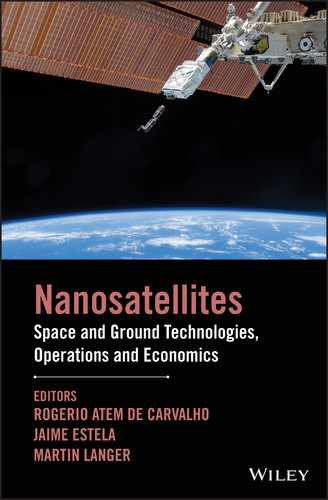Nanosatellites: Space and Ground Technologies, Operations and Economics Rogerio Atem de Carvalho, Instituto Federal Fluminense, Brazil Jaime Estela, Spectrum Aerospace Group, Germany and Peru Martin Langer, Technical University of Munich, Germany Covering the latest research on nanosatellites Nanosatellites: Space and Ground Technologies, Operations and Economics comprehensively presents the latest research on the fast-developing area of nanosatellites. Divided into three distinct sections, the book begins with a brief history of nanosatellites and introduces nanosatellites technologies and payloads, also explaining how these are deployed into space. The second section provides an overview of the ground segment and operations, and the third section focuses on the regulations, policies, economics, and future trends. Key features: Nanosatellites: Space and Ground Technologies, Operations and Economics is a comprehensive reference for researchers and practitioners working with nanosatellites in the aerospace industry.
Table of Contents
- Cover
- List of Contributors
- Foreword: Nanosatellite Space Experiment
- Introduction by the Editors
- 1 I-1: A Brief History of Nanosatellites
- 2 I-2a: On-board Computer and Data Handling
- 3 I-2b: Operational Systems
- 4 I-2c: Attitude Control and Determination
- 5 I-2d: Propulsion Systems
- 6 I-2e: Communications
- 7 I-2f: Structural Subsystem
- 8 I-2g: Power Systems
- 8.1 Introduction
- 8.2 Power Source: Photovoltaic Solar Cells and Solar Array
- 8.3 Energy Storage: Lithium-ion Batteries
- 8.4 SA-battery Power Conditioning: DET and MPPT
- 8.5 Battery Charging Control Loops
- 8.6 Bus Power Conditioning and Distribution: Load Converters and Distribution Switches
- 8.7 Flight Switch Subsystem
- 8.8 DC/DC Converters
- 8.9 Power System Sizing: Power Budget, Solar Array, and Battery Selection
- 8.10 Conclusions
- References
- 9 I-2h: Thermal Design, Analysis, and Test
- 10 I-2i: Systems Engineering and Quality Assessment
- 11 I-2j: Integration and Testing
- 12 I-3a: Scientific Payloads
- 12.1 Introduction
- 12.2 Categorization
- 12.3 Imagers
- 12.4 X-ray Detectors
- 12.5 Spectrometers
- 12.6 Photometers
- 12.7 GNSS Receivers
- 12.8 Microbolometers
- 12.9 Radiometers
- 12.10 Radar Systems
- 12.11 Particle Detectors
- 12.12 Plasma Wave Analyzers
- 12.13 Biological Detectors
- 12.14 Solar Sails
- 12.15 Conclusions
- References
- 13 I-3b: In-orbit Technology Demonstration
- 14 I-3c: Nanosatellites as Educational Projects
- 15 I-3d: Formations of Small Satellites
- 15.1 Introduction
- 15.2 Constellations and Formations
- 15.3 Orbit Dynamics
- 15.4 Satellite Configurations
- 15.5 Relevant Specific Small Satellite Technologies to Enable Formations
- 15.6 Application Examples
- 15.7 Test Environment for Multisatellite Systems
- 15.8 Conclusions for Distributed Nanosatellite Systems
- Acknowledgments
- References
- 16 I-3e: Precise, Autonomous Formation Flight at Low Cost
- 17 I-4a: Launch Vehicles—Challenges and Solutions
- 18 I-4b: Deployment Systems
- 19 I-4c: Mission Operations
- 20 I-5: Mission Examples
- 21 II-1: Ground Segment
- 22 II-2: Ground Station Networks
- 22.1 Introduction
- 22.2 Technological Challenges
- 22.3 Visibility Clash Problems of Stations and Satellites
- 22.4 The Distributed Ground Station Network
- 22.5 Infrastructure
- 22.6 Planning and Scheduling
- 22.7 Generic Software Architecture
- 22.8 Example Networks
- 22.9 Traditional Ground Station Approach
- 22.10 Heterogeneous Ground Station Approach
- 22.11 Homogeneous Ground Station Approach
- 22.12 Conclusions
- References
- 23 II-3: Ground-based Satellite Tracking
- 24 II-4a: AMSAT
- 24 II-4b: New Radio Technologies
- 25 III-1a: Cost Breakdown for the Development of Nanosatellites
- 26 III-1b: Launch Costs
- 27 III-2a: Policies and Regulations in Europe
- 28 III-2b: Policies and Regulations in North America
- 29 III-2c: International Organizations and International Cooperation
- 30 III-3a: Economy of Small Satellites
- 30.1 Introduction
- 30.2 Rethinking the Value Chain
- 30.3 A Hybrid Small Satellite Value Chain
- 30.4 Evolution, Not Revolution?
- 30.5 The Economics at Play
- 30.6 Satellite Manufacturers
- 30.7 Launch Service Providers
- 30.8 Satellite Operators
- 30.9 Satellite Servicing Providers
- 30.10 Data and Solution Providers
- 30.11 A Shift Toward New Models
- References
- Further Reading
- Notes
- 31 III-3b: Economics and the Future
- 32 III-3c: Networks of Nanosatellites
- Index
- End User License Agreement
